Animals
Animals That Look Like Possums: 10 Fascinating Species
Curious about animals resembling possums? Meet captivating species like the Kinkajou with unique features that will leave you intrigued.
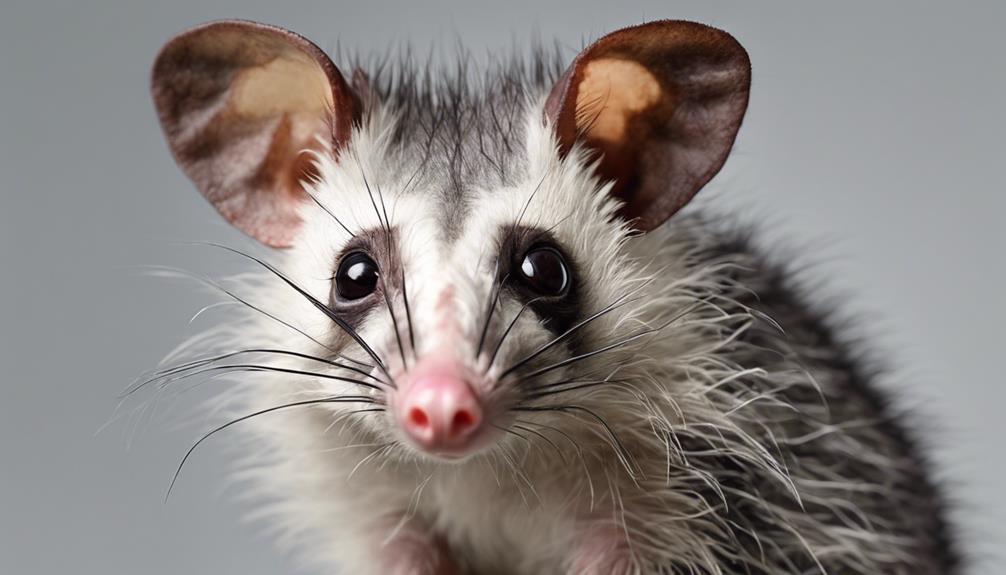
If you're curious about animals that resemble possums, there are fascinating species to discover. The Sugar Glider, known for its prehensile tail, is native to Australia and Indonesia. The Ringtail Cat, part of the raccoon family, has a distinctive banded tail for balance and communication. Bushbabies, found in Africa, are nocturnal primates with specialized adaptations for leaping. The Kinkajou from Central and South America sports a long prehensile tail and sharp claws for climbing. Cuscus, arboreal marsupials in Australia and the Pacific, have unique tree-dwelling adaptations. And there are more intriguing species to explore!
Key Takeaways
- Sugar Glider: Prehensile tail, endangered, from Australia and Indonesia.
- Ringtail Cat: Banded tail, part of raccoon family, sharp claws for climbing.
- Bushbaby: Nocturnal, leaping abilities, vocal communication, found in Africa.
- Kinkajou: Prehensile tail, fruit eater, nocturnal with forward-facing eyes.
- Cuscus: Arboreal marsupials, herbivorous, nocturnal, found in Australia and Pacific Islands.
Sugar Glider
Sugar gliders, with their ability to gracefully glide through the air, are enchanting nocturnal marsupials native to Australia and Indonesia. These medium-sized mammals possess a remarkable feature – their prehensile tails, which aid in balancing and steering their aerial adventures.
Despite their mesmerizing presence, sugar gliders face a concerning reality; they're critically endangered in the wild due to habitat loss and illegal pet trade practices. As a responsible pet owner, it's vital to understand the importance of preserving the natural habitats of these fascinating creatures and to avoid contributing to the illegal wildlife trade.
Ringtail Cat
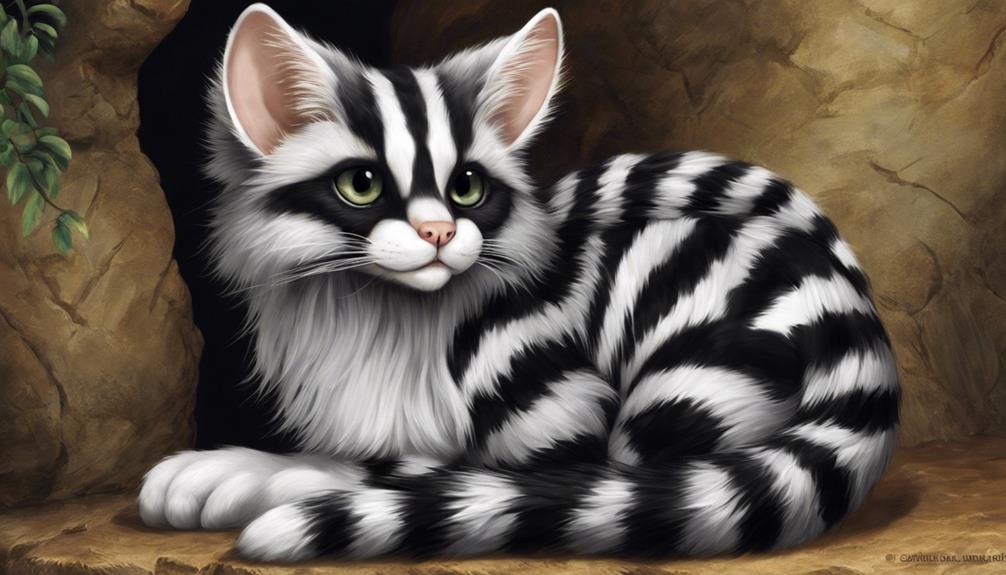
Ringtail cats, often mistaken for felines, are actually part of the raccoon family. Their distinctive feature is the long, banded tail that aids in balance and communication.
Understanding their unique physical traits, habitat preferences, and conservation needs can help us appreciate and protect these fascinating creatures.
Unique Physical Features
With a long, bushy tail adorned with alternating black and white rings, the Ringtail Cat exhibits distinctive physical features that set it apart from other animals resembling possums. Here are some unique characteristics that make the Ringtail Cat stand out:
- Contrasting Colors: The black and white rings on their bushy tail create a striking visual pattern.
- Large Eyes and Pointed Snout: Similar to a cat, their facial features include large, round eyes and a pointed snout.
- Lighter Underside: The fur on their underside is lighter than the rest of their body, adding to their unique appearance.
- Sharp, Curved Claws: Their feet are equipped with sharp, curved claws that aid in climbing and gripping onto branches.
These features contribute to the Ringtail Cat's agility and ability to thrive in their natural habitat.
Habitat and Behavior
Traversing the rugged terrain of North America, Ringtail cats demonstrate exceptional climbing skills, utilizing their long, prehensile tails for balance and agility. These fascinating creatures are primarily found in Mexico and the southwestern United States, where they spend most of their time in trees, hunting for insects, small mammals, and birds under the cover of night.
Ringtail cats are solitary and nocturnal, with a diet that includes fruits and vegetation. Remarkably, they've a unique social structure where males have overlapping territories with several females. While they may look similar to raccoons, Ringtail cats are a separate species with their own distinct behaviors and habitats.
It's intriguing to note that despite being closely related, raccoons are much larger than Ringtail cats.
Conservation Status
Amid ongoing conservation efforts, the Ringtail Cat maintains a stable population trend and is currently listed as Least Concern by the IUCN Red List.
- Two species: The Ringtail Cat, despite its name, isn't a feline but belongs to the raccoon family, making it one of the two species in its genus Bassariscus.
- Million years ago: The evolutionary history of the Ringtail Cat traces back millions of years, with fossil records indicating their presence in North America.
- Individuals left: Despite facing some habitat loss and human interference, Ringtail Cats continue to thrive, with conservation efforts ensuring their populations remain healthy.
- Conserving habitats: Preserving diverse habitats like forests, deserts, and urban areas is essential to safeguarding the Ringtail Cat's future and minimizing human-wildlife conflicts.
Bushbaby
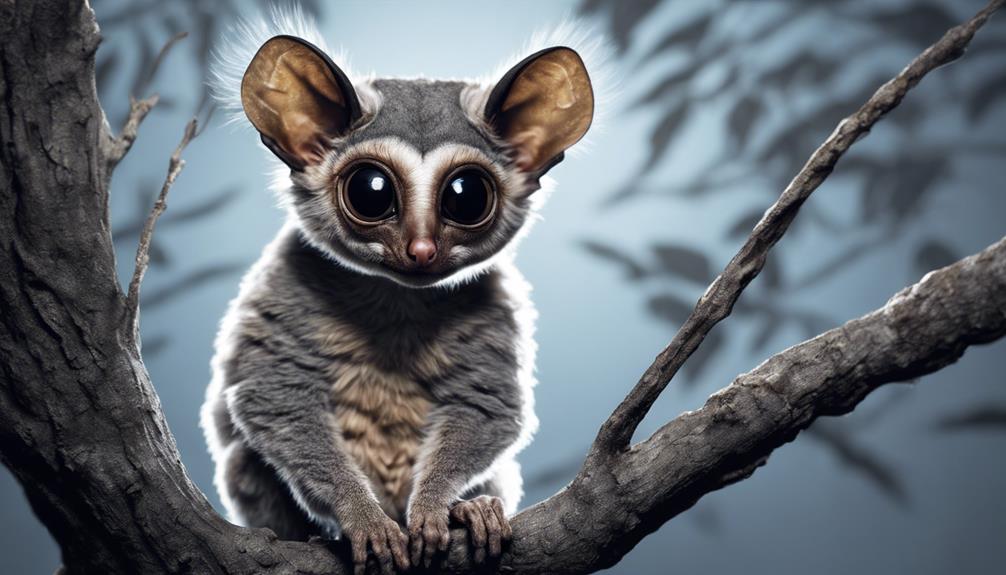
Bushbabies, also known as galagos, are fascinating creatures found in Africa. They possess unique behavior traits, inhabit specific habitats, and have distinct diet preferences.
Let's explore the intriguing world of bushbabies and learn more about their nocturnal lifestyle and survival strategies.
Bushbaby Behavior Traits
Known for their distinctive large eyes and excellent night vision, bushbabies are small, nocturnal primates with specialized adaptations for leaping and balancing. Observing bushbabies in their natural habitat reveals fascinating behavior traits such as:
- Vocal Communication: Bushbabies use various vocalizations like chirps, whistles, and screams to mark territory and locate potential mates.
- Diverse Diet: Their diet includes insects, fruits, gums, and tree sap, showcasing their adaptability to different food sources.
- Solitary or Group Living: Bushbabies can be solitary creatures or live in small family groups, with some species forming monogamous pairs.
- Agile Movement: These primates exhibit agile movements, utilizing their long tails for balance and strong hind legs for impressive leaping abilities.
These behaviors contribute to the bushbabies' survival and success in their environments.
Bushbaby Habitat Facts
Exploring the diverse habitats of bushbabies reveals their remarkable adaptation to varying environments in sub-Saharan Africa. These nocturnal primates can be found in savannas, lowland forests, and bushlands. Their specialized adaptations, like strong hind legs for jumping and excellent night vision, make them well-suited for these habitats. Bushbabies are known for their distinctive call that sounds like a crying baby and their ability to leap long distances. In addition to their unique characteristics, they play an important role in their ecosystems by dispersing seeds, aiding in the regeneration of plant species. Below is a table highlighting some fascinating facts about bushbaby habitats:
| Habitat Type | Description |
|---|---|
| Savannas | Open grasslands with scattered trees |
| Lowland Forests | Dense forests with rich biodiversity |
| Bushlands | Scrublands with bushes and shrubs |
| Nocturnal | Active during the night |
| Seed Dispersers | Aid in plant species regeneration |
Bushbaby Diet Preferences
Feasting on a diverse array of insects, fruits, tree gums, and small animals, bushbabies exhibit a versatile diet that varies depending on their species and habitat's food availability.
Here are some interesting facts about the bushbaby diet preferences:
- Bushbabies primarily feed on insects, such as crickets, grasshoppers, and caterpillars, which are essential protein sources.
- Fruits are also a significant part of their diet, providing vital vitamins and nutrients.
- Tree gums serve as a source of carbohydrates and energy for these small primates.
- Their ability to consume a wide range of food items contributes to their adaptability in various environments, showcasing their resourcefulness in finding sustenance.
Kinkajou

With its long, prehensile tail and sharp claws, the Kinkajou effortlessly navigates the rainforest canopy in search of its fruit-based diet. These intriguing creatures, also known as 'honey bears,' are native to Central and South America. Their tail aids in moving through trees, while their claws help them climb and grip branches. Here is a visual representation of some interesting facts about Kinkajous:
| Fact | Description |
|---|---|
| Diet | Primarily fruits, nectar, with occasional insects and small animals. |
| Nocturnal Habits | Large, forward-facing eyes for low-light vision, active during the night. |
| Defense Mechanism | Can be aggressive when threatened, using sharp teeth and claws for defense. |
These nocturnal animals may look cute, but they are equipped to defend themselves when needed. Their unique characteristics and behaviors make them a fascinating species to learn about in the diverse ecosystem of the rainforest.
Cuscus
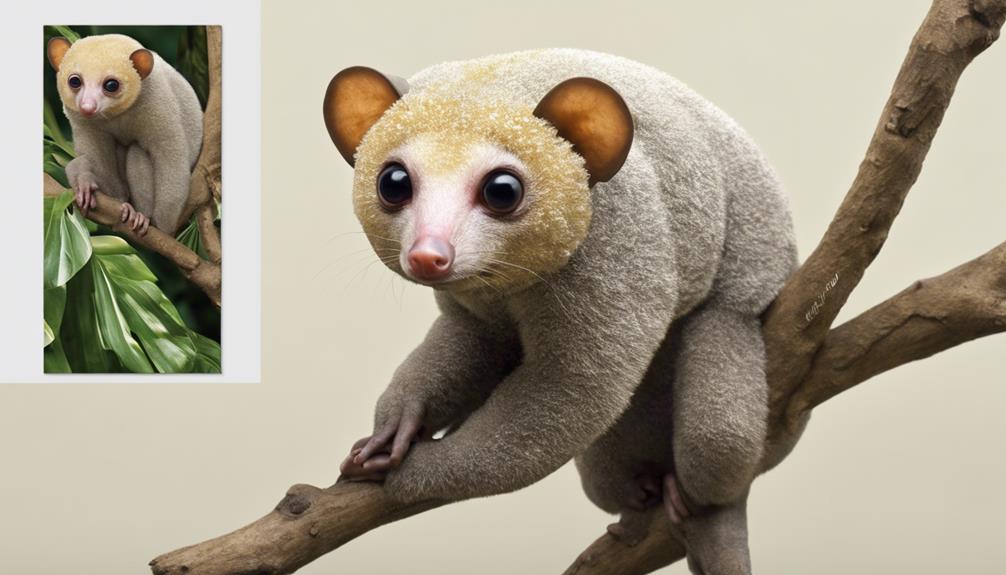
Cuscus, a type of marsupial, can be found in Australia and New Guinea. They've a unique feature – a prehensile tail that helps them climb and hang in trees.
Their diet includes fruits, leaves, and small animals, and they're known for being gentle creatures.
Cuscus Appearance Features
Sporting a round face with large eyes and rounded ears, the Cuscus marsupials found in New Guinea and parts of Australia display a distinctive appearance. Here are some key features of the Cuscus:
- Prehensile Tail: Cuscus have a unique tail that's prehensile, meaning it can grasp objects like branches, aiding them in climbing and hanging from trees.
- Variety of Fur Colors: Their fur can vary in color from gray to brown to reddish, helping them blend into their forest habitats.
- Arboreal Lifestyle: Cuscus are primarily arboreal creatures, spending most of their time in trees where they're well-adapted to move around and find food.
- Distinct Facial Features: With their round face, large eyes, and rounded ears, Cuscus have a charming and distinctive appearance that sets them apart from other marsupials.
Cuscus Habitat and Diet
In the lush rainforests of New Guinea and northern Australia, arboreal marsupials known as Cuscus sustain themselves primarily on a diet consisting of leaves, fruits, flowers, and occasionally insects. Cuscus play an essential role in seed dispersal within their forest habitats. Their prehensile tail aids in moving through trees and maintaining balance while foraging. These slow-moving creatures blend seamlessly into the canopy, camouflaging with their surroundings. Let's explore the habitat and diet of Cuscus through the table below:
| Cuscus Habitat | Cuscus Diet |
|---|---|
| Lush Rainforests | Leaves |
| New Guinea & Northern Australia | Fruits |
| Arboreal Living | Flowers |
| Canopy | Occasionally Insects |
| Seed Dispersal Role |
Quokka
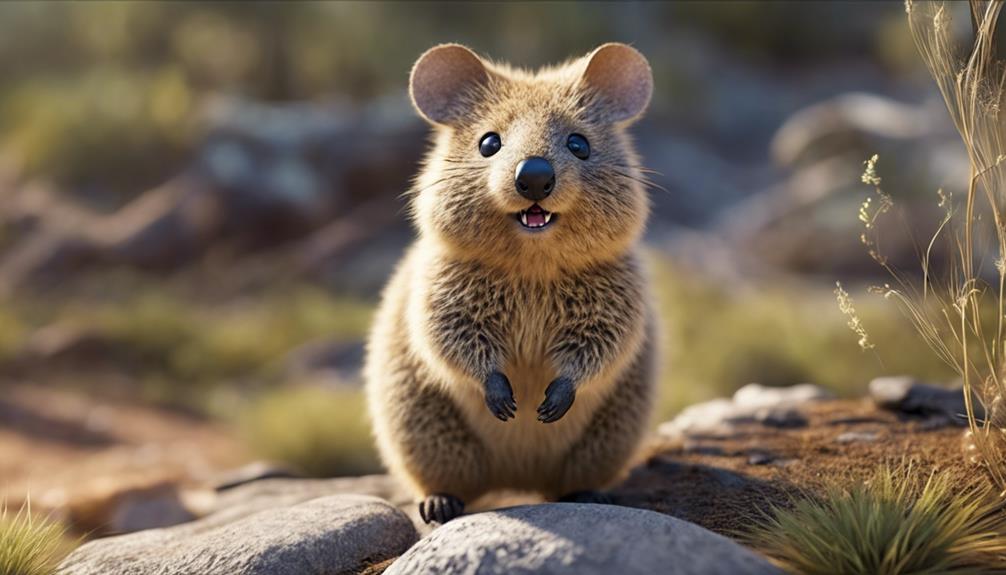
Found on Rottnest Island and Bald Island in Western Australia, the Quokka is renowned as the happiest animal in the world. Here are some fascinating facts about these adorable creatures:
- Nocturnal Herbivores: Quokkas primarily feed on grasses, leaves, and succulents, which contribute to their friendly and approachable nature.
- Population Decline: Unfortunately, Quokka populations have decreased due to habitat destruction and the introduction of predators in their limited range, emphasizing the need for conservation efforts.
- Tourist Attractions: Quokkas have become a tourist attraction, drawing people who seek selfies with these photogenic and smiley animals due to their irresistibly cute demeanor.
- Conservation Efforts: Various initiatives are in place to protect the Quokka and preserve their habitat, aiming to prevent further declines in their population.
These engaging facts provide insight into the unique characteristics and challenges faced by Quokkas, making them a species worth learning more about and protecting for future generations.
Olinguito
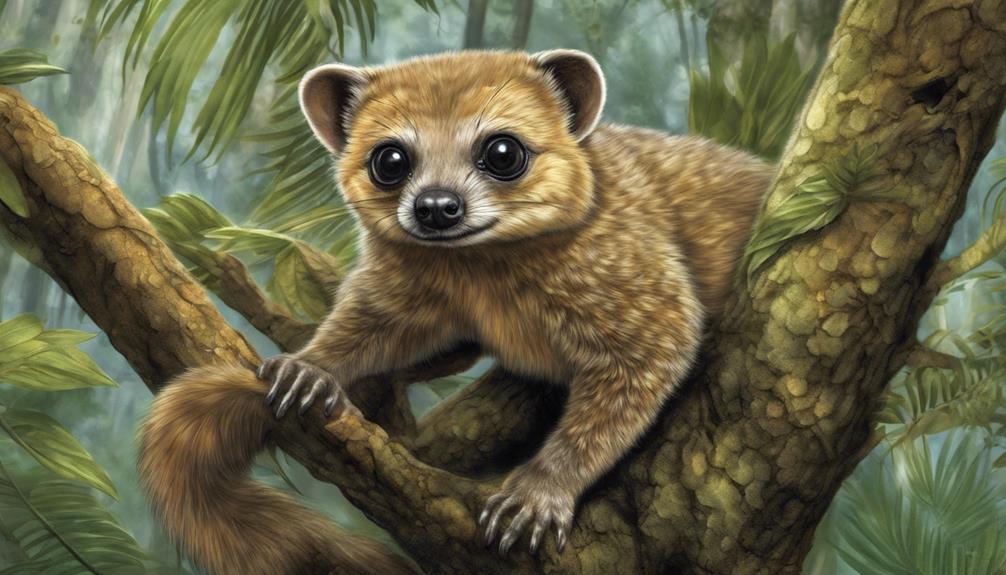
The Olinguito, a small, furry mammal native to the cloud forests of Colombia and Ecuador, was officially recognized as a distinct species in 2013. These charming creatures are part of the raccoon family but bear a striking resemblance to a mix between a house cat and a teddy bear. Olinguitos primarily feed on fruit, nectar, and insects in their forest habitat. They are solitary animals, and females give birth to one offspring at a time.
| Olinguito Facts | |
|---|---|
| Habitat | Cloud forests |
| Diet | Fruit, nectar, insects |
| Reproduction | Solitary, one offspring |
Olinguitos are known for their nocturnal habits, making them elusive and fascinating to study. Their discovery in 2013 marked a significant milestone in the world of zoology, showcasing the continuous exploration and discovery of new species on our planet. The Olinguito's unique appearance and behavior make it an intriguing subject of research and a delightful addition to the animal kingdom.
Tarsier
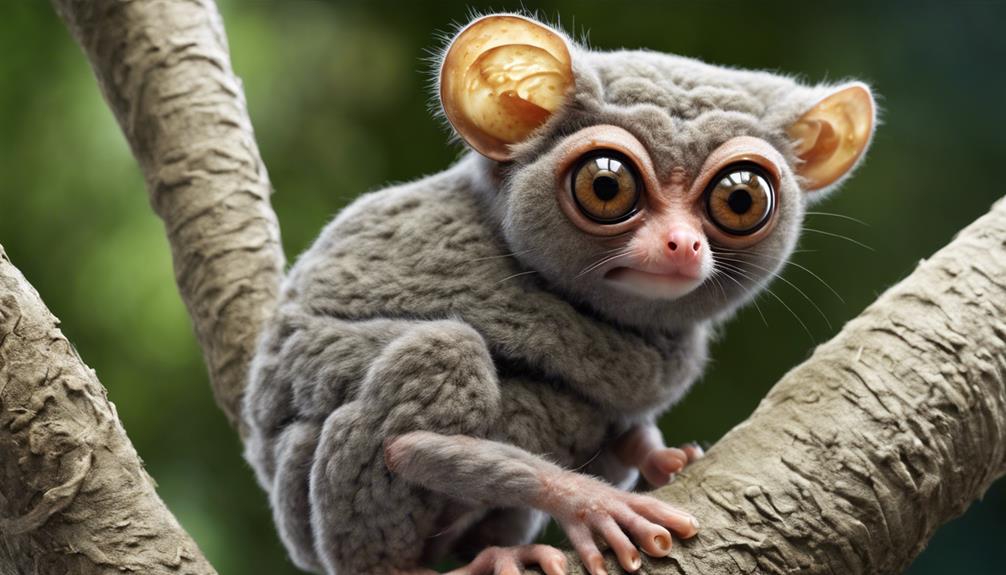
With their large eyes and unique vocalizations, tarsiers captivate observers in the forests of Southeast Asia. These small primates are fascinating creatures that exhibit remarkable characteristics:
- Physical Features: Tarsiers have big eyes, long hind limbs, and a lengthy tail, making them distinct from other primates.
- Habitat: Found primarily in the islands of Borneo, Sumatra, and the Philippines, tarsiers inhabit dense forests where they can thrive in their natural environment.
- Diet: These carnivorous animals feed on insects like crickets, beetles, and grasshoppers, showing their preference for a protein-rich diet.
- Communication: Tarsiers communicate through high-pitched calls, using unique vocalizations that set them apart from other animals in the region.
Observing tarsiers in their natural habitat provides a glimpse into the wonders of the animal kingdom. Their specialized ankle bone enables them to leap incredible distances, showcasing their agility and adaptation to their environment.
Aye-Aye
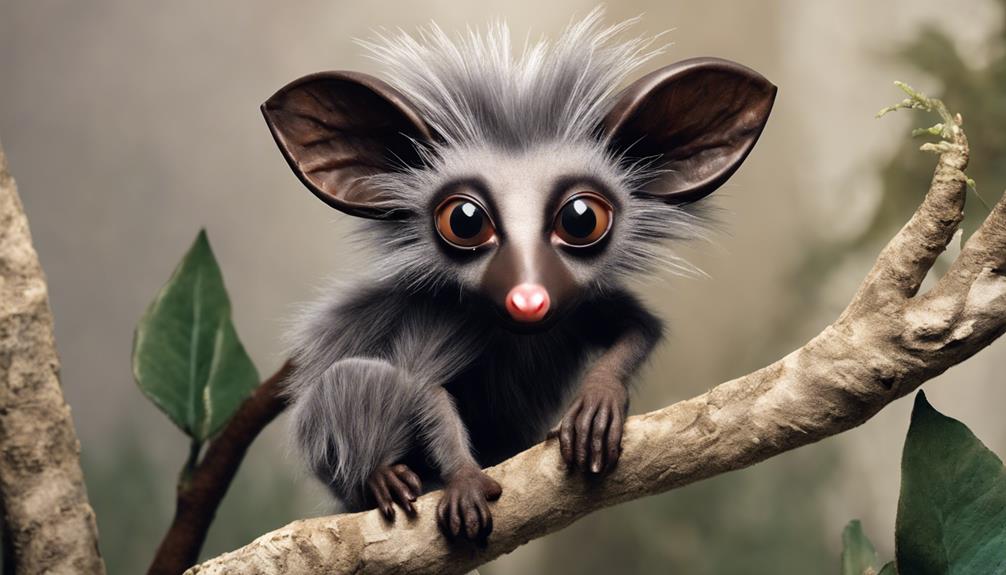
Tarsiers' distinctive features in the forests of Southeast Asia captivate observers, but now let's explore the fascinating world of the Aye-Aye, a lemur species native to Madagascar. The Aye-Aye stands out with its striking appearance, boasting large eyes, bat-like ears, and a remarkable long, thin middle finger specifically adapted for extracting insects from tree bark. Despite its captivating features, the Aye-Aye faces challenges due to superstitions in some Malagasy cultures, where it's considered a symbol of bad luck, leading to persecution and habitat destruction.
These nocturnal creatures spend their daylight hours nestled in nests crafted from leaves and branches, emerging under the moonlight to hunt for their favorite insect meals. To safeguard the Aye-Aye from extinction, conservation efforts are essential. Habitat preservation initiatives and captive breeding programs are in place to protect these unique lemurs and guarantee their survival for future generations to marvel at their extraordinary characteristics.
Flying Squirrel

Catching a glimpse of a flying squirrel in action is a mesmerizing experience, showcasing their remarkable gliding abilities. Here are some fascinating facts about these unique creatures:
- Flying squirrels aren't true squirrels but are actually gliding mammals found in various parts of the world, from North America to Asia.
- They possess a specialized membrane called a patagium that extends from their wrists to their ankles, enabling them to glide gracefully through the air.
- These nocturnal creatures have large eyes adapted for low-light conditions, aiding them in their nightly adventures.
- Their diet consists of nuts, seeds, fruits, and insects, varying depending on the species and the environment they inhabit.
Witnessing a flying squirrel effortlessly navigate through the trees with its acrobatic aerial skills is a demonstration to the wonders of nature and the adaptability of these remarkable creatures.
Frequently Asked Questions
What Animal Is Similar to the Opossum?
A creature resembling the opossum is the Striped Possum, known for its unique traits like using an elongated fourth finger for feeding and emitting unpleasant odors for defense. Its distinct vocalizations add to its fascinating nature.
Which 5 Animals Are Marsupials?
There are five animals that are marsupials: kangaroos, wallabies, koalas, possums, and Tasmanian devils. These creatures give birth to underdeveloped young that continue to grow in a pouch. Their unique reproductive system sets them apart from other mammals.
What Is a Mini Kangaroo Looking Animal?
I'll tell you about the Lumholtz's tree-kangaroo. It's like a mini kangaroo and lives in Queensland. These unique animals are vulnerable due to habitat loss and climate change, so it's essential to protect them.
What Is a Bandicoot Look Like?
As I explore the description of a bandicoot, I envision a creature with a pointed snout and a hunched posture, skillfully using its front paws to unearth insects. These marsupials, with their keen senses, thrive in diverse Australian habitats.
Can Small Bugs That Look Like Miniature Praying Mantises Be Mistaken for Possums?
Yes, small bugs resembling praying mantises can be mistaken for possums due to their similar appearance from a distance. These tiny creatures, with their long, delicate limbs and slender bodies, can easily be confused with possums at first glance. However, upon closer inspection, their distinct features become more apparent.
Conclusion
To sum up, the animal kingdom is filled with fascinating creatures that resemble possums in various ways. From the acrobatic Sugar Glider to the mysterious Aye-Aye, each species has unique characteristics that make them stand out.
Just like how each person has their own special qualities that make them unique, these animals showcase the diversity and wonder of nature. So next time you see a possum or one of its look-alikes, take a moment to appreciate the beauty and complexity of the animal world.
Dana is our Lead Content Writer, bringing a wealth of knowledge and expertise to our team. With a background deeply rooted in animal studies and a profound love for all creatures, Dana is dedicated to crafting engaging and informative content that resonates with our audience. With Dana at the helm, you can trust that our content is accurate and engaging, catering to the diverse interests of animal enthusiasts everywhere.
Animals
Discover ABC Siberian Cattery: 7 Essential Facts
Peek into the world of ABC Siberian Cattery, where premium quality Siberian forest cats await – a purrfect adventure awaits!

In 2010, ABC Siberian Cattery was established to breed quality Siberian forest cats. They maintain high breeding standards, offering hypoallergenic TICA certified cats, and even collaborated with National Geographic. Neva Masquerade, Traditional Siberian, and Color-point Siberian breeds are available, known for being hypoallergenic. Their cats undergo vet-approved care practices with regular health check-ups, vaccinations, and grooming. The adoption process includes a detailed application, personal conversations, and verification checks. ABC Siberian Cattery values customer satisfaction, provides excellent care, and plans to expand their breeding program. Discover more about ABC Siberian Cattery's exceptional standards and future developments.
Key Takeaways
- Established in 2010 with high breeding standards.
- Offers Neva Masquerade, Traditional, Color-point Siberian breeds.
- Focus on hypo-allergenic TICA certified cats.
- Emphasizes vet-approved health and care practices.
- Known for exceptional customer service and transparency.
History of ABC Siberian Cattery
Established in 2010, I founded ABC Siberian Cattery with a vision to breed high-quality Siberian forest cats. Our journey began with a deep passion for Siberian cats and a dedication to upholding the highest standards in breeding. Over the years, we've meticulously refined our techniques to produce hypo-allergenic Siberian cats that are TICA certified.
Our website uses a strict Privacy Policy to guarantee the safety of our customers' data. At ABC Siberian Cattery, we take pride in our commitment to excellence, reflected in our partnership with National Geographic for a feature on our breeding practices. Our history is a proof of our unwavering dedication to specialized breeding practices and exceptional care for our feline companions.
Breeds Available at ABC Siberian Cattery

At ABC Siberian Cattery, we offer a variety of Siberian forest cat breeds for adoption. These breeds are known for their hypo-allergenic qualities, making them popular choices for families with allergies.
Visit our cattery to find the perfect Siberian forest cat breed that suits your preferences and lifestyle.
Available Breeds
Regularly, ABC Siberian Cattery introduces a variety of Siberian forest cat breeds for adoption, each meticulously raised with care and attention to guarantee their health and well-being.
| Neva Masquerade | Traditional Siberian | Color-point Siberian |
|---|---|---|
| Hypo-allergenic | Purebred | Unique color patterns |
| Blue eyes | Thick, water-repellent coat | Playful and affectionate |
These breeds at ABC Siberian Cattery offer a mix of hypo-allergenic qualities, unique coat characteristics, and distinct personalities. Whether you're drawn to the striking appearance of the Neva Masquerade, the classic beauty of the traditional Siberian, or the color variations of the color-point Siberian, each cat is thoughtfully bred to bring joy and companionship to your home.
Popular Choices
Among the popular choices available at ABC Siberian Cattery are the Neva Masquerade, Traditional Siberian, and Color-point Siberian breeds, each offering unique qualities that cater to different preferences.
The Neva Masquerade stands out with its stunning blue eyes and color-point markings, adding a touch of elegance to any household.
Traditional Siberian cats boast a thick, water-repellent coat perfect for cold climates, while their playful and affectionate nature makes them wonderful companions.
For those seeking a breed with striking color variations on their ears, paws, and tails, the Color-point Siberian is an excellent choice.
These breeds not only bring beauty but also charm and personality to your home, making them popular picks among cat enthusiasts looking for innovative and exceptional feline companions.
Health and Care Standards

At ABC Siberian Cattery, we implement vet-approved care practices and rigorous health monitoring procedures to guarantee the well-being of our Siberian forest cats.
Our commitment to maintaining high health and care standards involves regular check-ups, vaccinations, and preventative measures to keep our cats healthy and happy.
Vet-Approved Care Practices
Ensuring the health and well-being of our Siberian forest cats, ABC Siberian Cattery diligently follows vet-approved care practices. We prioritize regular veterinary check-ups, vaccinations, and preventative care for all our cats.
Proper grooming, parasite control, and dental care are also essential in maintaining peak health standards for our feline friends. At ABC Siberian Cattery, we provide a clean and safe environment with ample space for exercise and mental stimulation, promoting overall well-being.
Adhering to high care standards, we monitor our cats diligently for any signs of illness or distress, ensuring early intervention when necessary. Your cat's health is our top priority, and we're committed to providing the best care possible to keep them happy and healthy.
Health Monitoring Procedures
In our cattery, maintaining high health and care standards involves strict health monitoring procedures for all our Siberian forest cats. We conduct regular veterinary check-ups and health assessments to guarantee the well-being of our feline friends. This includes vaccinations, parasite control, and early detection of any potential health issues.
Detailed records of each cat's health history are kept, allowing us to provide necessary treatments promptly. At ABC Siberian Cattery, we prioritize preventive care and swift medical attention to uphold peak health for all our cats. By following stringent health monitoring protocols, we aim to guarantee the happiness and longevity of our beloved Siberian forest cats.
Adoption Process and Policies

I aid potential adopters through a thorough application process, interviews, and reference checks to guarantee the best match for our Siberian forest cats. When considering adopting a Siberian forest cat from ABC Siberian Cattery, here are some key points to keep in mind:
- Detailed Application Process: Our adoption process involves filling out a comprehensive application form to help us understand your lifestyle and preferences.
- Personal Conversations: We conduct discussions to make sure that both the adopter and the cat will be a good fit for each other.
- Verification Checks: References are contacted to authenticate the information provided and to ensure the well-being of our cats in their new homes.
We believe in creating lasting and fulfilling relationships between our Siberian forest cats and their new families. Our adoption policies are designed to make the process smooth and successful for both the adopters and our beloved feline friends.
Customer Testimonials and Reviews
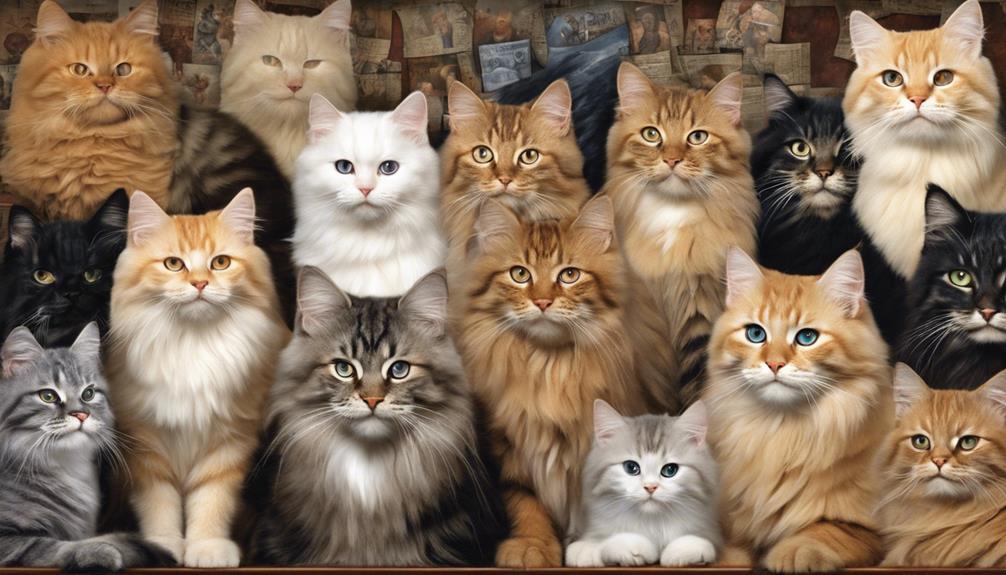
Receiving glowing testimonials and reviews, ABC Siberian Cattery stands out for its exceptional customer service and high-quality support. Customers praise the cattery for its dedication to providing excellent care for Siberian forest cats. Reviews consistently highlight the outstanding quality of the cats bred at ABC Siberian Cattery, emphasizing their health and well-being.
Testimonials frequently mention the detailed information provided during the adoption process, showcasing the cattery's commitment to transparency and education. Many customers express satisfaction with the adoption experience, underscoring ABC Siberian Cattery's reputation for excellence in every step of the process.
This positive feedback not only reflects the quality of service but also indicates a high level of customer satisfaction. ABC Siberian Cattery's consistent delivery of exceptional customer support and the premium quality of its Siberian forest cats are key factors contributing to its strong reputation in the industry.
Meet the Team at ABC Siberian Cattery

Comprised of dedicated breeders with a profound love for Siberian forest cats, the team at ABC Siberian Cattery excels in providing exceptional care and support for their feline companions.
- Our team consists of experienced breeders who are passionate about Siberian forest cats.
- We prioritize excellent care, nutrition, and socialization for all our cats.
- Each team member plays an essential role in maintaining the health, well-being, and development of our beloved cats.
At ABC Siberian Cattery, we work together seamlessly to make sure that every cat, including those from litters like Fifi's, receives individualized attention and love. Our collective expertise and unwavering commitment contribute to the high standards and exceptional quality of Siberian cats bred here. We take pride in our innovative approaches to cat care and continuously aim to set new benchmarks in the breeding industry.
Future Plans and Developments

Expanding our breeding program to introduce new bloodlines and enhance genetic diversity is a key focus for ABC Siberian Cattery's future plans and developments. By incorporating advanced health and genetic testing protocols, we aim to ensure the well-being of our future litters.
Additionally, we're diligently working on creating a more interactive online platform to provide potential adopters with the opportunity to engage with our available litters actively. Collaborations with other reputable breeders are in progress to exchange knowledge and enhance our breeding practices.
Moreover, we're exploring options to offer educational resources and guidance to new cat owners, ensuring a seamless adoption experience. Our commitment to innovation and excellence propels us to continuously improve our breeding program, providing healthy and well-adjusted Siberian cats for loving homes.
Stay tuned for exciting updates as we endeavor to elevate our standards and make a positive impact in the feline breeding community.
Frequently Asked Questions
What Are Some Fun Facts About Siberian Cats?
Siberian cats, known for their hypoallergenic coats and ancient Russian origins, display intelligence and loyalty. Their triple coat protects in cold climates. Playful and affectionate, they exhibit dog-like traits, following owners around.
How Fast Can Siberian Cats Run?
Siberian cats can sprint up to 30 miles per hour, showcasing their speed and agility. Their powerful hind legs and wild ancestry contribute to this impressive running ability. Owners should provide space for them to exercise.
What Are the Features of the Siberian Forest Cat?
The Siberian forest cat boasts a hypo-allergenic coat and a robust physique designed for harsh climates. They excel in agility, forming strong bonds with humans and pets alike. Their intelligence fuels playful exploration, making them delightful companions.
When Was the Siberian Cat Discovered?
I stumbled upon the fascinating history of Siberian cats during a late-night browsing session. It was astonishing to learn that the breed has been documented since 1000 AD, making them one of the oldest cat breeds known.
Conclusion
So there you have it, folks! ABC Siberian Cattery is the purrfect place to find your new feline friend.
With a rich history, high-quality care standards, and a team dedicated to the well-being of their cats, you can't go wrong.
Just remember, adopting a cat is a lifelong commitment, so make sure you're ready for the responsibility.
Happy cat hunting!
Dana is our Lead Content Writer, bringing a wealth of knowledge and expertise to our team. With a background deeply rooted in animal studies and a profound love for all creatures, Dana is dedicated to crafting engaging and informative content that resonates with our audience. With Dana at the helm, you can trust that our content is accurate and engaging, catering to the diverse interests of animal enthusiasts everywhere.
Animals
3 Important Facts: False
Astonishing truths about common misconceptions await in '3 Important Facts: False', challenging what you thought you knew.

Swimming after eating doesn't cause cramps, salt doesn't make water boil faster, and MSG won't give you headaches. It's important to know these facts to stay informed. Always wait before swimming after a meal, add salt for taste not speed, and MSG is safe in moderation. Check labels for hidden MSG. Remember these key details for a better understanding of common misconceptions. Explore more facts to expand your knowledge and challenge what you know. Understand the truth behind popular beliefs for a clearer perspective on the world around you. More truths await discovery in the world of myths and misconceptions.
Key Takeaways
- Milk does not increase mucus production in the body.
- Alcohol does not kill brain cells as commonly believed.
- Caffeine does not dehydrate the body contrary to popular belief.
- Napoleon was not unusually short; he was of average height for his era.
- Historical inaccuracies can distort our understanding of significant figures like Napoleon.
Common Misconceptions Debunked
Dispelling common myths and misconceptions is vital for understanding the truth behind various beliefs. It's intriguing how many false ideas people believe without questioning.
For instance, contrary to popular belief, swimming after eating doesn't cause cramps. This misconception has been debunked by scientific evidence, showing that digestion doesn't divert enough blood flow to cause cramping while swimming.
Additionally, the idea that adding salt makes water boil faster is also false. The boiling point of water remains constant regardless of salt content, as confirmed by basic chemistry principles.
Furthermore, MSG doesn't cause headaches as many people believe. Studies have shown that MSG, a flavor enhancer, doesn't trigger headaches in the majority of individuals.
It's essential to question and verify these common misconceptions to enhance our understanding of the world around us.
False Beliefs About Animals
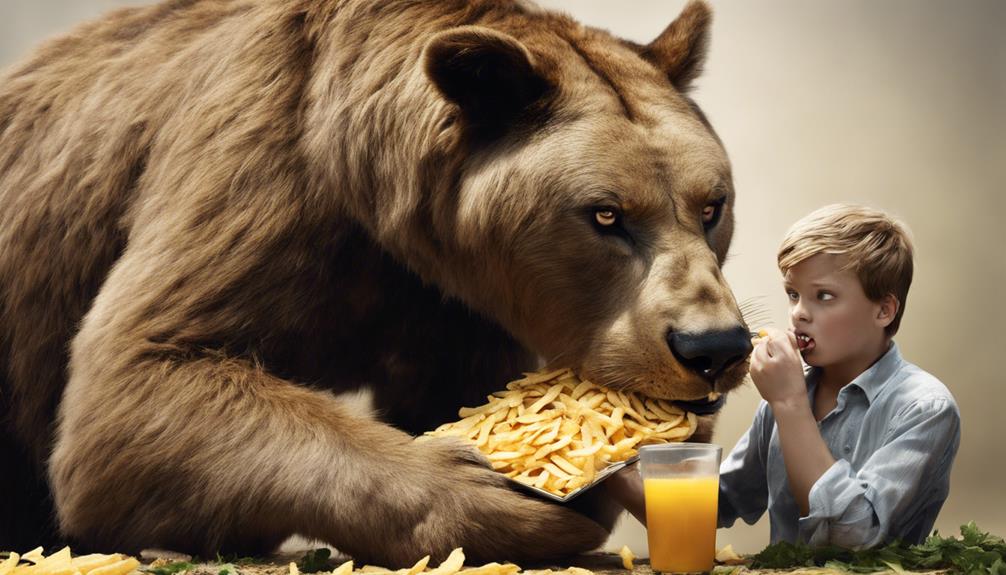
Let's debunk some common misconceptions about animals.
From chameleons changing colors for mood and communication to birds not abandoning their babies because of human touch, there's more to animal behaviors than meets the eye.
Goldfish have memories that extend beyond a few seconds, bats aren't blind, and bulls are provoked by movement, not just the color red.
Animal Communication Myths
Many people mistakenly believe that animals change color primarily to blend in with their surroundings, but the truth is much more complex. Chameleons change their color not just for camouflage, but also to communicate with other chameleons, regulate their body temperature, and display their emotions.
Animal communication involves a variety of signals such as vocalizations, body language, scents, and visual displays. For example, dogs communicate through barks, body posture, tail wagging, and facial expressions. Birds use calls, songs, and visual displays to communicate with each other and establish territories.
Animals have intricate communication systems that include warning signals, mating calls, and social interactions. Understanding these communication methods can give us a deeper insight into the fascinating world of animal behavior.
Animal Intelligence Misconceptions
Animals, often misunderstood in their capabilities, exhibit intelligence far beyond common misconceptions. Contrary to the belief that goldfish have a mere 3-second memory, they actually possess memories that last longer.
Dogs, often thought to see only in black and white, do have color vision and can perceive a range of colors. Chameleons don't change color to blend in with surroundings; instead, they alter their hue based on mood, temperature, and communication needs.
Birds can safely digest rice without the risk of exploding, dispelling the myth. Additionally, bats, often portrayed as blind, actually have specialized adaptations for hunting in darkness. These facts show that animals possess remarkable intelligence, proving that even Einstein failed to fully grasp the extent of their cognitive abilities.
Health Myths Unveiled

Dispelling common health myths can lead to a better understanding of how our bodies function. Let's explore some fascinating facts to uncover the truth behind prevalent misconceptions. Below is a table that highlights some intriguing health myths and the actual facts that debunk them:
| Health Myth | Fact |
|---|---|
| Milk increases mucus production | Scientifically proven false |
| Alcohol kills brain cells | Debunked by research findings |
| Caffeine dehydrates the body | Incorrect when consumed in moderation |
Understanding the reality behind these myths can empower us to make informed decisions about our health. Next, we will investigate more misconceptions related to historical inaccuracies. Stay tuned for the debunking of commonly believed historical myths.
Historical Inaccuracies Exposed

Historical inaccuracies can often distort our understanding of the past. Misrepresented events, factual errors, and revisionist accounts can all contribute to these misconceptions.
It's essential to critically examine historical narratives to uncover the truth behind these inaccuracies.
Misrepresented Events
Challenging common misconceptions, historical inaccuracies regarding notable figures like Napoleon are being exposed. The belief that Napoleon was unusually short is one of these misrepresented events.
Contrary to popular belief, Napoleon was actually of average height for his time, standing at 1.68m. This misconception likely arose from historical inaccuracies and has no factual basis. In reality, his height fell within the normal range for a Frenchman of his era.
The myth of Napoleon's short stature has been perpetuated by inaccurate information over the years. By uncovering these misrepresented events, we can gain a more accurate understanding of historical figures like Napoleon and dispel long-standing myths.
Factual Errors
Revealing factual errors in historical accounts is essential for gaining a more accurate understanding of the past. To explore some misconceptions that have been lost through the head, let's examine a comparison table of popular historical inaccuracies:
| Historical Error | Truth Revealed |
|---|---|
| Napoleon had a Napoleon complex | Napoleon was actually 1.68m tall, not short-tempered |
| Three wise men were kings | They were not kings, contrary to popular belief |
| Humans coexisted with dinosaurs | Dinosaurs and humans did not live together in history |
| Benjamin Franklin discovered electricity | Electricity was not discovered through a kite experiment |
| Ninjas wore black suits | Ninjas did not typically wear black suits as shown in media |
Revisionist Accounts
Revisiting historical inaccuracies can reshape our understanding of the past, shedding light on misconceptions that have persisted over time. When it comes to the notion that abandon babies were routinely left on church doorsteps in the past, historical research reveals a more nuanced reality. While instances of abandoning infants did occur, they weren't as prevalent as previously thought.
Scientific Misunderstandings Clarified

Understanding the complexities of human sensory systems beyond the traditional five senses is essential for dispelling common misconceptions in scientific knowledge. Our ability to sense body heat is one such example. While not often considered a traditional sense, the perception of temperature is vital for maintaining homeostasis and responding to environmental changes. Our skin contains thermoreceptors that detect heat and cold, sending signals to the brain for interpretation. This sensory input helps us avoid burns, regulate body temperature, and even experience the comforting warmth of a hug.
Furthermore, our capacity to sense temperature is intertwined with other senses, such as touch and pain. The intricate network of sensory neurons allows us to distinguish between gentle warmth, intense heat, and painful burns. By understanding the multifaceted nature of our sensory systems, we can appreciate the remarkable ways our bodies perceive and interact with the world around us.
Urban Legends Debunked

Urban legends often spread misinformation and misconceptions that can be easily debunked with factual evidence and critical thinking. Let's explore the world of debunking urban legends with the help of three wise facts.
| Urban Legend Debunked | Factual Evidence | Critical Thinking |
|---|---|---|
| Great Wall from Space | Multiple man-made objects visible from space, not just the Great Wall of China | Consider the vast size of Earth and the technology used to view it from space |
| Glass as Slow Liquid | Glass is an amorphous solid with a disordered atomic structure | Examine the scientific properties of glass and how it differs from liquids |
| Mother Birds Abandoning | Mother birds do not abandon their babies if touched by humans | Understand the natural instincts of birds and how they care for their young |
| Taste Bud Distribution | Taste buds are distributed evenly across the tongue | Experiment with different tastes on various parts of the tongue |
| Ancient Spherical Earth | Ancient civilizations, like the Greeks, knew the Earth was spherical | Research historical evidence and scientific knowledge from ancient times |
Mythbusting in Popular Culture

After exploring urban legends debunked, the focus now shifts to mythbusting in popular culture, shedding light on common misconceptions and truths in society. Popular TV shows like 'MythBusters' have played a significant role in bringing mythbusting into mainstream entertainment. These shows entertain while simultaneously educating viewers on the importance of separating fact from fiction.
Social media platforms and websites also contribute to spreading awareness about myths and truths, fostering a culture of critical thinking. By engaging in mythbusting activities, individuals of all ages can't only enjoy the process but also enhance their understanding of the world around them. It's vital to remember that mythbusting serves a dual purpose – not only does it entertain, but it also helps combat the spread of misinformation.
Embracing the principles of mythbusting can empower individuals to question what they hear and see, ultimately leading to a more informed and discerning society.
Debunked Everyday Myths
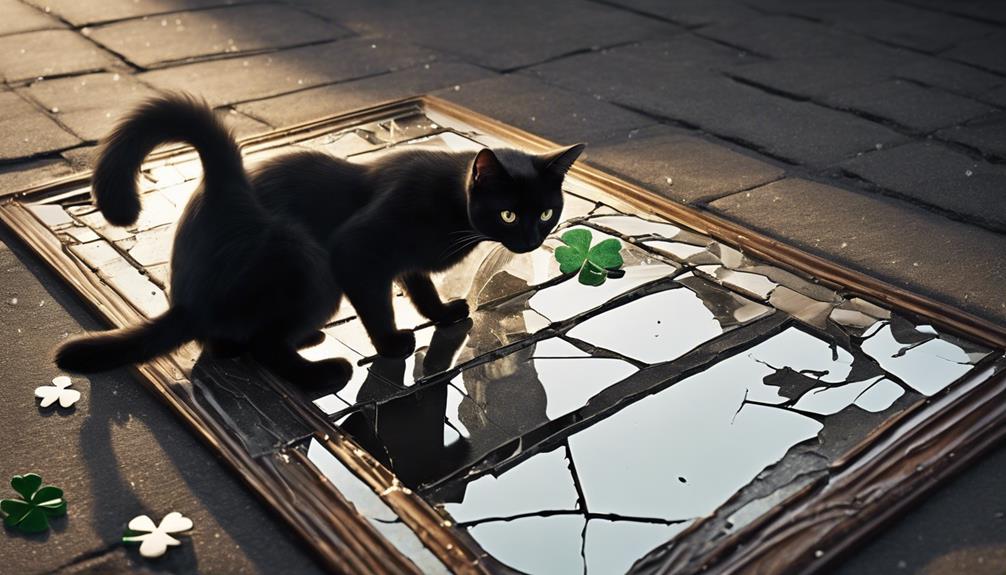
Swimming after eating doesn't cause cramps, contrary to popular belief; debunked everyday myths shed light on common misconceptions in society.
Let's explore another fascinating myth: the notion of left and right brain dominance. In the past, it was widely believed that individuals were either left-brained, analytical, and logical, or right-brained, creative, and intuitive. However, recent research has debunked this myth, revealing that both hemispheres of the brain work together in harmony for most tasks.
While certain functions may be more lateralized to one side, such as language processing being more dominant in the left hemisphere for most people, the idea of being distinctly left or right-brained is oversimplified. Our brains are incredibly complex, with intricate networks connecting various regions to perform tasks.
Understanding the true nature of brain function can help us appreciate the brain's versatility and adaptability, debunking the outdated myth of left and right brain dominance.
Frequently Asked Questions
Can a Fact Be Proven False?
Indeed, facts can be proven false. Evidence, research, and verified sources debunk inaccurate information. Critical thinking is vital to discern truth. Updating beliefs based on new evidence guarantees accuracy. It is imperative to challenge and verify information.
What Is an Example of a Myth and a Fact?
In cooking, a myth is that salt speeds up water boiling; in reality, it's a misconception. An example of a fact is that both sides of the brain can learn various skills, debunking the idea of strict divisions.
Did You Know Weird Facts?
Yes, I'm well-versed in weird facts! Birds using Xbox controllers and otters tricking birds with fish scales are fascinating examples. Learning about animals like owls, cats, and snakes always keeps me intrigued.
What Are Random Facts About Me?
I enjoy embracing heights of flavor in diverse cuisines, yet tremble at the thought of literal heights. My love for reading takes me on fantastical journeys, while Luna, my playful feline, keeps me grounded.
Conclusion
To sum up, remember to always question and investigate information before accepting it as true. By debunking common misconceptions and myths, we can expand our knowledge and understanding of the world around us.
Stay skeptical, seek out reliable sources, and don't be afraid to challenge popular beliefs. Keep learning and growing, and you'll be able to separate fact from fiction with ease.
Dana is our Lead Content Writer, bringing a wealth of knowledge and expertise to our team. With a background deeply rooted in animal studies and a profound love for all creatures, Dana is dedicated to crafting engaging and informative content that resonates with our audience. With Dana at the helm, you can trust that our content is accurate and engaging, catering to the diverse interests of animal enthusiasts everywhere.
Animals
Leopards Vs Wolves: 5 Key Differences
Traverse the contrasting worlds of leopards and wolves, uncovering intriguing divergences in habitat, size, behavior, and hunting techniques.

When comparing leopards and wolves, here are five key differences to note. Gray wolves roam North America, Europe, Asia, and a bit of Africa, while African leopards dwell in over 35 African countries. Wolves adapt to various environments such as tundra, forests, and deserts, while leopards navigate habitats from deserts to rainforests. Wolves stand taller and heavier compared to leopards, influencing power dynamics. Leopards display stealth and ambush in solitary hunting, while wolves rely on teamwork and communication within packs. These variations in habitat, size, speed, behavior, and hunting methods showcase their distinct survival strategies.
Key Takeaways
- Wolves are social animals, while leopards are solitary hunters.
- Wolves exhibit higher speeds (up to 65 km/h) compared to leopards (56-60 km/h).
- Leopards have a stronger bite force (500-600 psi) than wolves (400-661 psi).
- Wolves rely on teamwork for hunting, while leopards use stealth and ambush tactics.
- Size-wise, male leopards are heavier (up to 91 kg) than male wolves (around 40 kg).
Habitat Range and Distribution
Among the key differences between leopards and wolves lies their distinct habitat range and distribution across various continents. Gray wolves, known for their adaptability, can be found in North America, Europe, Asia, and a small part of Africa. In contrast, African leopards are native to over 35 African countries.
Wolves thrive in diverse ecosystems such as arctic tundra, forests, prairies, grasslands, and deserts. On the other hand, leopards exhibit remarkable versatility, inhabiting habitats ranging from deserts to rainforests in Africa. The adaptability of leopards to a wide range of environments showcases their unique survival skills.
Despite the global distribution of grey wolves, the more regionally specific habitat of African leopards highlights their ability to thrive in varying conditions. Understanding these habitat differences is essential in appreciating the distinct ways in which a leopard would navigate its surroundings compared to grey wolves.
Size and Weight Discrepancies
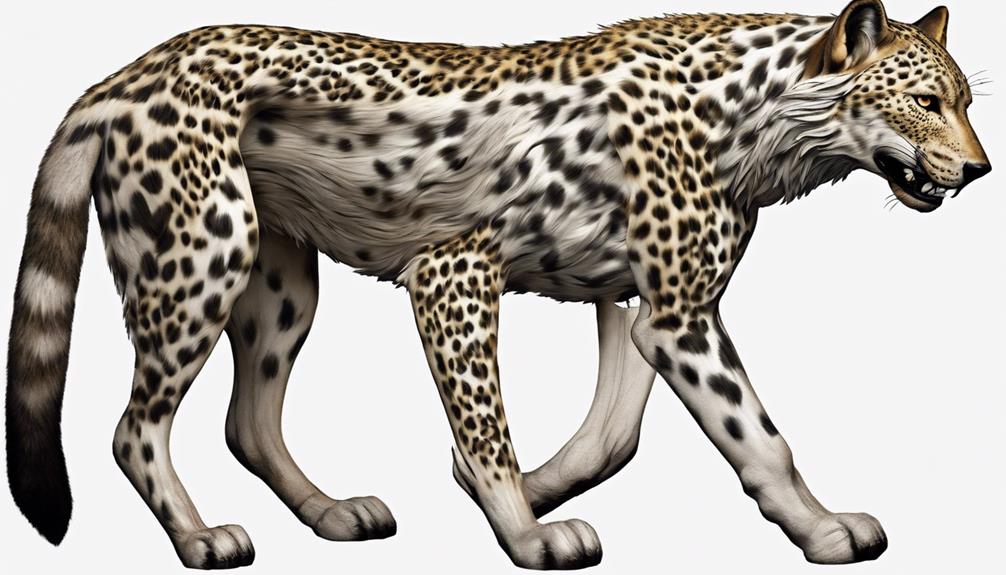
Comparing the size and weight differences between leopards and wolves reveals significant disparities that can influence the dynamics of their interactions. When looking at these measurements, it becomes clear that leopards are generally heavier than grey wolves. Male leopards typically weigh around 60 kg, while male wolves weigh approximately 40 kg.
Additionally, the average length of a male leopard ranges from 3 to 6.2 feet, whereas a grey wolf can reach up to 6.6 feet in length. Regarding height, wolves stand taller at 2.4 feet compared to leopards at 2.2 feet at the shoulder.
It's interesting to note that leopards have been recorded at higher weights, with the heaviest male reaching a whopping 91 kg, surpassing the average weight of a wolf. These size and weight differences can be vital in understanding the power dynamics between these big cats and wolves.
Speed and Agility Variances

Speed and agility play pivotal roles in shaping the dynamics between wolves and leopards during their interactions in the wild. When it comes to a chase, wolves have the upper hand with speeds reaching up to 65 km/h, surpassing the African leopard's top speed of 56-60 km/h. This speed advantage gives wolves the edge in quick pursuits, especially when compared to leopards, who are slower than cheetahs and lions.
In a confrontation, the higher top speed of wolves becomes a critical factor, potentially influencing the outcome between a wolf vs. one of the leopards. Additionally, wolves' agility shines as they can swiftly maneuver through various terrains, contrasting with the slightly slower movements of leopards. Understanding these speed and agility variances is essential as they've a significant impact on the hunting and fighting strategies of both wolves and leopards in the wild.
Intelligence and Social Behaviors
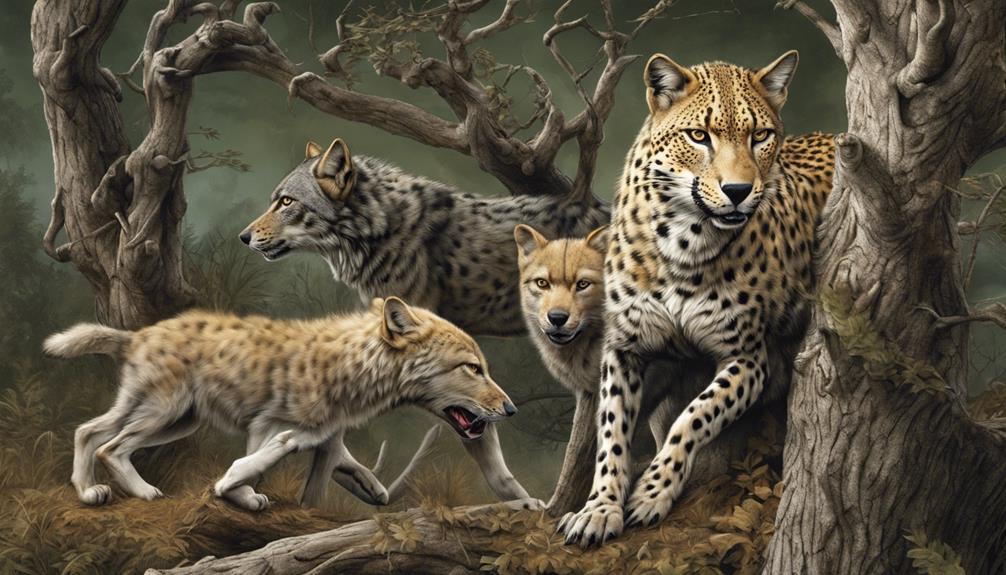
In understanding the dynamics between wolves and leopards, their differing levels of intelligence and social behaviors play a crucial role in shaping their respective interactions in the wild.
Wolves are renowned for their high intelligence, which is reflected in their ability to form complex social structures within their packs. They communicate through various vocalizations, body language, and scent marking, all of which contribute to maintaining pack cohesion and successful hunting strategies.
On the other hand, while leopards are intelligent in their own right, they don't exhibit the same level of complex social behaviors as wolves. Leopards are solitary creatures, preferring to hunt and live independently without the need for social interactions.
This contrast in social dynamics highlights the teamwork and cooperation essential for wolves' survival, in contrast to the self-reliant and solitary nature of leopards. The way these animals interact and communicate with each other greatly influences their hunting techniques and overall success in the wild.
Bite Force and Hunting Techniques
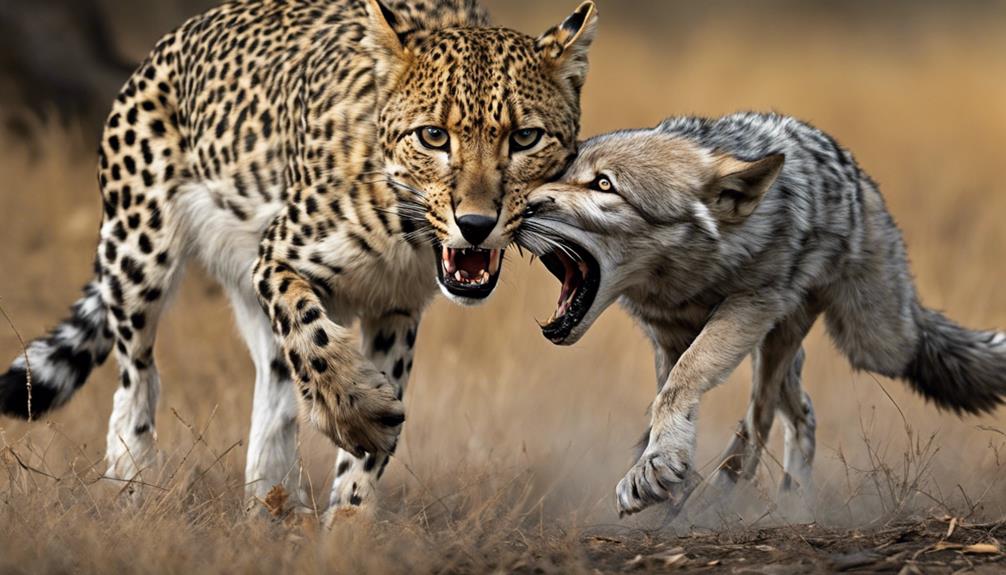
While the intelligence and social behaviors of wolves and leopards set them apart, a significant distinction can be found in their respective bite forces and hunting techniques.
- Wolves, with a bite force ranging from 400-661 psi, rely on this strength for gripping and tearing prey during hunts.
- Leopards, on the other hand, possess a bite force of 500-600 psi and use their powerful jaws to deliver a suffocating bite, often targeting the throat.
- Wolves showcase cooperative hunting tactics, working together to take down larger prey efficiently.
- In contrast, leopards are solitary hunters, employing stealth and ambush techniques to catch their prey effectively.
The differences in bite force and hunting techniques between wolves and leopards highlight the unique strategies each species has evolved to survive in their respective habitats. Wolves' cooperative efforts allow them to tackle larger prey, while leopards' solitary nature emphasizes stealth and precision in their hunting methods. This diversity in approach showcases the adaptability and resourcefulness of these apex predators.
Frequently Asked Questions
What Is the Difference Between a Snow Leopard and a Wolf?
The key difference between a snow leopard and a wolf is their hunting style. Snow leopards are stealthy, solitary hunters, while wolves are social pack animals that hunt cooperatively. Each species has its unique strategy for survival.
Are Leopards Stronger Than Wolves?
Yes, leopards are stronger than wolves when it comes to individual power. Leopards possess greater strength and agility, giving them an advantage in one-on-one encounters. Wolves rely on teamwork and numbers to compensate for their lesser individual strength when facing leopards.
Is Wolf Better Than Leopard?
I'd say the wolf's cunning and pack mentality make it more adaptable and strategic, but the leopard's agility and stealth give it a unique advantage. Both are formidable in their own right, each excelling in different aspects.
Who Would Win a Wolf or Clouded Leopard?
In a face-off between a wolf and a clouded leopard, the agile leopard's stealth and speed could outmaneuver the wolf's strength. But teamwork might give the wolf an edge. It's a battle of wits and tactics.
Conclusion
To sum up, when it comes to comparing leopards and wolves, it's evident that leopards reign supreme in every aspect. From their vast habitat range to their unmatched speed and agility, leopards outshine wolves in every way.
Their intelligence and social behaviors set them apart, not to mention their powerful bite force and hunting techniques. In the battle of leopards vs wolves, the leopard emerges as the ultimate predator of the wild.
Dana is our Lead Content Writer, bringing a wealth of knowledge and expertise to our team. With a background deeply rooted in animal studies and a profound love for all creatures, Dana is dedicated to crafting engaging and informative content that resonates with our audience. With Dana at the helm, you can trust that our content is accurate and engaging, catering to the diverse interests of animal enthusiasts everywhere.
-

 Vetted2 months ago
Vetted2 months ago15 Best Cat Foods for Managing Hyperthyroidism – Vet Approved and Feline Friendly
-

 Animal Facts2 months ago
Animal Facts2 months agoSpring Animals: A Guide to Seasonal Wildlife
-

 Cats7 months ago
Cats7 months agoTop 5 Cat Breeders in Arkansas: A Guide
-

 Vetted1 month ago
Vetted1 month ago15 Best Dog Foods for Kidney Disease – Expert Recommendations for Your Pet's Health
-

 Vetted2 months ago
Vetted2 months ago15 Best Fresh Dog Food Delivery Services for Your Pup's Health and Happiness
-

 Rabbits2 months ago
Rabbits2 months agoExploring Rabbit Holes: What Do They Look Like?
-

 Pets2 months ago
Pets2 months agoLatest Pet Statistics in US – Trends & Insights in 2024
-

 Fish2 months ago
Fish2 months agoKeeping Your Sucker Fish Thriving at Home





















